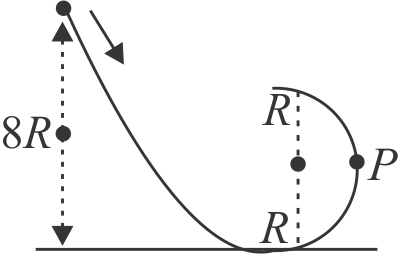366041
A small solid ball (mass \({=0.1 {~kg}}\)) rolls without slipping along the track shown in the figure. The radius of the circular track is \({R}\). If the ball starts from rest at a height \({8 R}\) above the bottom, the horizontal force acting on it at point \({P}\) is \({5 x}\) newton. Find the value of \({x}\) (Given, \({g=10 {~ms}^{-2}}\))
366043
Assertion :
A body rolls down an inclined plane without slipping. The fraction of total energy associated with its rotation will depend on its radius of gyration.
Reason :
Total kinetic energy of rolling body is equal to addition of kinetic energy of rotation and kinetic energy of translation.
366041
A small solid ball (mass \({=0.1 {~kg}}\)) rolls without slipping along the track shown in the figure. The radius of the circular track is \({R}\). If the ball starts from rest at a height \({8 R}\) above the bottom, the horizontal force acting on it at point \({P}\) is \({5 x}\) newton. Find the value of \({x}\) (Given, \({g=10 {~ms}^{-2}}\))
366043
Assertion :
A body rolls down an inclined plane without slipping. The fraction of total energy associated with its rotation will depend on its radius of gyration.
Reason :
Total kinetic energy of rolling body is equal to addition of kinetic energy of rotation and kinetic energy of translation.
366041
A small solid ball (mass \({=0.1 {~kg}}\)) rolls without slipping along the track shown in the figure. The radius of the circular track is \({R}\). If the ball starts from rest at a height \({8 R}\) above the bottom, the horizontal force acting on it at point \({P}\) is \({5 x}\) newton. Find the value of \({x}\) (Given, \({g=10 {~ms}^{-2}}\))
366043
Assertion :
A body rolls down an inclined plane without slipping. The fraction of total energy associated with its rotation will depend on its radius of gyration.
Reason :
Total kinetic energy of rolling body is equal to addition of kinetic energy of rotation and kinetic energy of translation.
366041
A small solid ball (mass \({=0.1 {~kg}}\)) rolls without slipping along the track shown in the figure. The radius of the circular track is \({R}\). If the ball starts from rest at a height \({8 R}\) above the bottom, the horizontal force acting on it at point \({P}\) is \({5 x}\) newton. Find the value of \({x}\) (Given, \({g=10 {~ms}^{-2}}\))
366043
Assertion :
A body rolls down an inclined plane without slipping. The fraction of total energy associated with its rotation will depend on its radius of gyration.
Reason :
Total kinetic energy of rolling body is equal to addition of kinetic energy of rotation and kinetic energy of translation.
